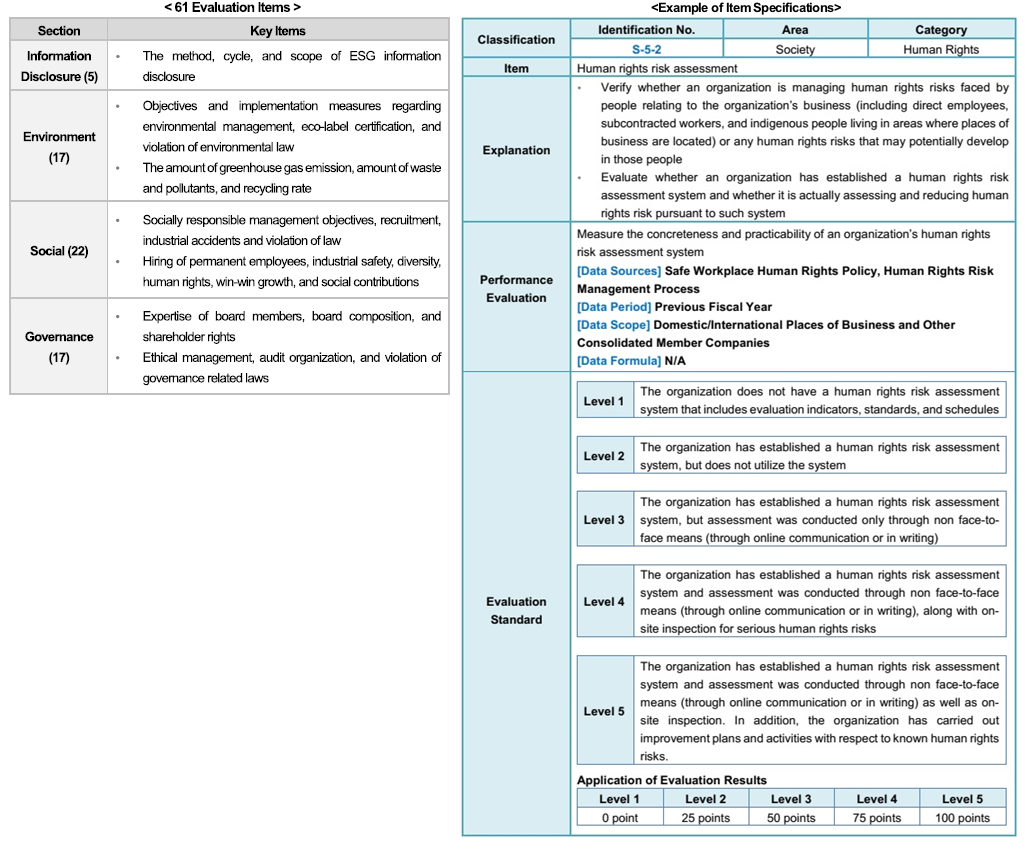On December 1, 2021, the Ministry of Trade, Industry and Energy (the “MOTIE”) released the “K-ESG Guidelines” as one of its main initiatives regarding the “ESG Infrastructure Expansion Plan” that was jointly announced by various government bodies in August 2021. Although interest in ESG management has been rapidly increasing, many companies have been left in the dark because of the lack of information on ESG measures and guidelines, and especially on how domestic and international rating agencies evaluate a company’s ESG management. Therefore, the purpose of the K-ESG Guidelines is to set forth the key elements of ESG management so that companies can freely put an effective ESG management into practice. However, the MOTIE makes it clear that the Korean government does not intend to use the K-ESG Guidelines for any government-level ESG evaluation regarding companies.
Based on more than 3,000 ESG evaluation and disclosure indicators provided by 13 major domestic and international ESG-related agencies (such as DJSI, MSCI, EcoVadis, Sustainalytics, WEF, and GRI), the K-ESG Guidelines set forth 27 “Social Values” that companies should pursue through ESG management. In addition, the guidelines provide 61 Evaluation Items and specific details for each item (“Item Specification”) so that companies can evaluate themselves on how well they are achieving such “Social Values.”
“Item Specifications” consist of: (1) an “Explanation” section which summarizes the purpose, content, and method regarding the Evaluation Items, (2) a “Performance Evaluation” section which provides data sources, data period, data scope, and data formula and explains how to review a company’s performance based on such information, and (3) an “Evaluation Standard” section which provides guidance for evaluating a company’s ESG management based on the information reviewed under the “Performance Evaluation” section. Each item is scored on the basis of five levels (with a maximum of 100 points) for each item in order to facilitate comparison of ESG performances (across companies or items) that have been subject to evaluation. In order to make it easier for companies to conduct self-evaluation, there is an “Additional Explanation” section at the end of the Item Specifications.
Through 61 Item Specifications, the K-ESG Guidelines provide the basic elements necessary for establishing an ESG management system. By utilizing the guidelines, companies can evaluate their own ESG status. The guidelines are designed in a way that allows companies as well as domestic ESG rating agencies to freely use the guidelines. The guidelines are also expected to contribute to a more transparent and mature rating market as they can be used not only by existing rating agencies, but also new rating agencies.
The K-ESG Guidelines provide the minimum standard and implementation method necessary for establishing an ESG management system in the real business world by considering consistency with global indicators, characteristics that are unique to the Korean market, and consistency with applicable laws and policies. However, please note that the K-ESG guidelines should be treated as a “bare minimum” rather than as an “all-encompassing” set of conditions for establishing an effective ESG management system. Therefore, companies should analyze and consider other ESG criteria required by various global evaluation and disclosure standards when establishing their ESG management system based on the K-ESG Guidelines.
The Korean government plans to update the K-ESG Guidelines once every one or two years to reflect global ESG standards and trends, and will also provide specific guidelines for various industries and companies of different sizes starting from 2022. We will keep you updated on future developments.
Related Topics







